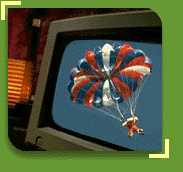
|


 igital photography offers computer users instant gratification and unlimited opportunities. These are compelling reasons why the market for digital cameras is growing rapidly. igital photography offers computer users instant gratification and unlimited opportunities. These are compelling reasons why the market for digital cameras is growing rapidly.


 According to Alexis Gerard, editor of The Future Image Report (Burlingame, Calif.), the leading business publication on digital photo-imaging, "Customers have enjoyed for years the flexibility and power that personal computers give them over words and numbers. What's generating all the excitement today is that it's now possible to apply those same benefits to photographs. And, digital cameras are the fastest, easiest way of bringing images into computers."
According to Alexis Gerard, editor of The Future Image Report (Burlingame, Calif.), the leading business publication on digital photo-imaging, "Customers have enjoyed for years the flexibility and power that personal computers give them over words and numbers. What's generating all the excitement today is that it's now possible to apply those same benefits to photographs. And, digital cameras are the fastest, easiest way of bringing images into computers."

 InfoTrend's Holch adds, "Because it's starting from ground zero, the growth will be fast. And digital photography is an easy-to-conceive, easy-to-understand concept - it's like regular photography, which people use everyday.
InfoTrend's Holch adds, "Because it's starting from ground zero, the growth will be fast. And digital photography is an easy-to-conceive, easy-to-understand concept - it's like regular photography, which people use everyday.

 "Digital photography is part of a cultural change towards using more images in our computing workspace. Human beings are visual creatures and we're getting more images into our computing workspace from the Web and from desktop publishing. That's why people want digital photography, along with the instant gratification of being able to immediately print or transmit their images."
"Digital photography is part of a cultural change towards using more images in our computing workspace. Human beings are visual creatures and we're getting more images into our computing workspace from the Web and from desktop publishing. That's why people want digital photography, along with the instant gratification of being able to immediately print or transmit their images."

 She adds, "It won't affect traditional photography, except at the high end. Both digital and conventional photography have their own space. The difference is that a digital camera is really a computer peripheral, while the conventional camera is a camera tool. People are used to paying in the hundreds of dollars for their computer peripherals, so the less than $500 cameras will have the highest unit shipments."
She adds, "It won't affect traditional photography, except at the high end. Both digital and conventional photography have their own space. The difference is that a digital camera is really a computer peripheral, while the conventional camera is a camera tool. People are used to paying in the hundreds of dollars for their computer peripherals, so the less than $500 cameras will have the highest unit shipments."

 Holch notes that there are some unknowns about how fast digital cameras will be adopted. "According to PMA (Photo Marketing Association), in 1995, 15 million conventional cameras, excluding disposables, were sold. But how many people have computers? How many want to use images with their computers? It's easy to take the picture, but to actually download and put them into action can be a challenge. And the pictures take up lots of space on a computer."
Holch notes that there are some unknowns about how fast digital cameras will be adopted. "According to PMA (Photo Marketing Association), in 1995, 15 million conventional cameras, excluding disposables, were sold. But how many people have computers? How many want to use images with their computers? It's easy to take the picture, but to actually download and put them into action can be a challenge. And the pictures take up lots of space on a computer."

 But even with these caveats, Holch notes, "The digital camera will really be paving new ground: images in the computing workspace. And it's not just for printing graphic images. Now people can drop images into their Web page, their employee newsletter or an electronic picture postcard. And soon, consumers will be able to drop off a photocard at the film processor to get quality prints, or to e-mail the image to a processor."
But even with these caveats, Holch notes, "The digital camera will really be paving new ground: images in the computing workspace. And it's not just for printing graphic images. Now people can drop images into their Web page, their employee newsletter or an electronic picture postcard. And soon, consumers will be able to drop off a photocard at the film processor to get quality prints, or to e-mail the image to a processor."
|

 igital photography offers computer users instant gratification and unlimited opportunities. These are compelling reasons why the market for digital cameras is growing rapidly.
igital photography offers computer users instant gratification and unlimited opportunities. These are compelling reasons why the market for digital cameras is growing rapidly. 

 igital photography offers computer users instant gratification and unlimited opportunities. These are compelling reasons why the market for digital cameras is growing rapidly.
igital photography offers computer users instant gratification and unlimited opportunities. These are compelling reasons why the market for digital cameras is growing rapidly. 